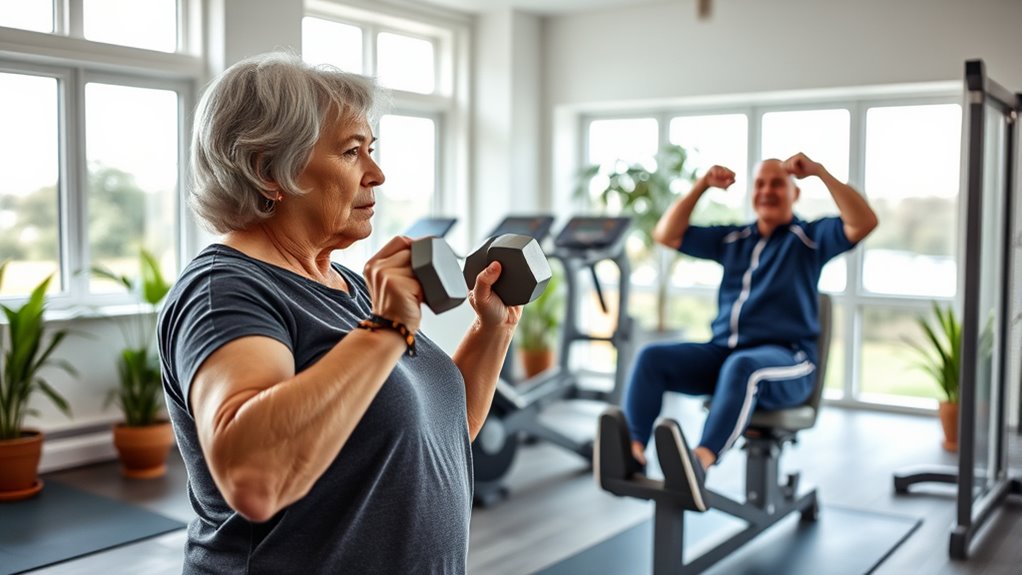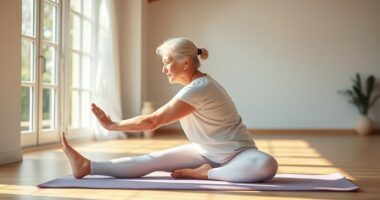To stay strong and balanced, focus on simple exercises like chair squats, seated bicep curls, and standing leg raises. Warm up first with light movement and dynamic stretches to prevent injuries. Use proper technique, start with light weights, and take it slow to see steady progress. Incorporate wall push-ups and balance exercises like single-leg stands for added safety. Keep going, and you’ll discover even more effective ways to boost your strength and confidence.
Key Takeaways
- Focus on low-impact exercises like chair squats and wall push-ups to enhance strength safely.
- Incorporate balance and stability exercises such as single-leg stands to prevent falls.
- Use light weights or resistance bands for controlled, gradual muscle strengthening.
- Prioritize proper technique and controlled movements to reduce injury risk.
- Include warm-up and stretching to improve flexibility and prepare muscles for strength training.
Warm-Up and Stretching Routines
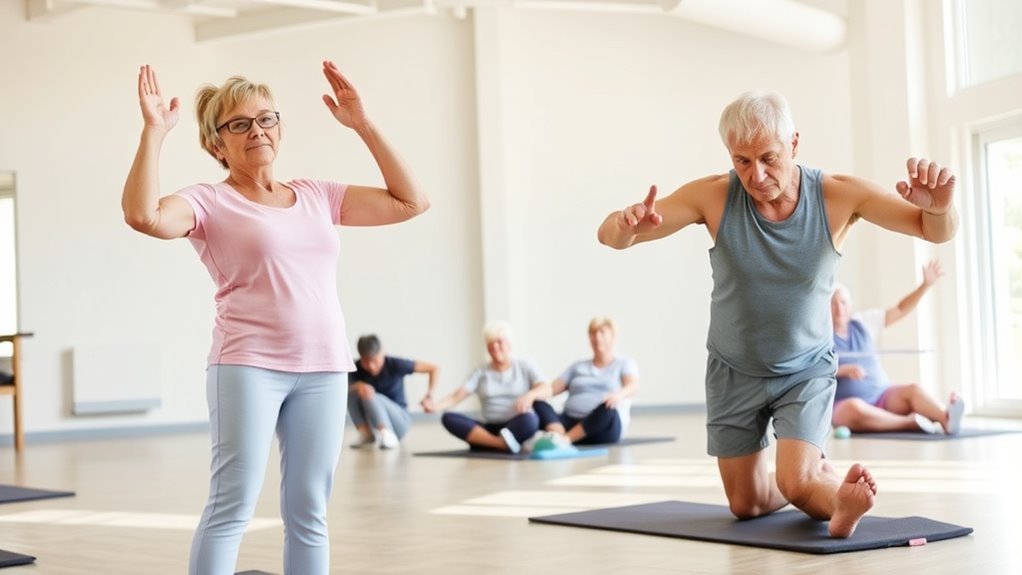
Before starting any strength training, it’s important to warm up and stretch to prepare your muscles and reduce the risk of injury. Warming up boosts elderly flexibility and enhances joint mobility, making exercises safer and more effective. Start with light cardio, like brisk walking or gentle marching in place, for 5-10 minutes to increase blood flow. Follow with dynamic stretches such as arm circles, leg swings, and neck tilts to loosen muscles and joints. These routines help improve your range of motion and prevent stiffness. Proper warm-up routines are essential for maintaining joint health and ensuring your body is ready for more intense activity. Taking these steps sets a solid foundation for safe, effective strength training sessions. Incorporating odor control features in some equipment can also help keep your workout environment fresh and comfortable.
Chair Squats for Lower Body Strength
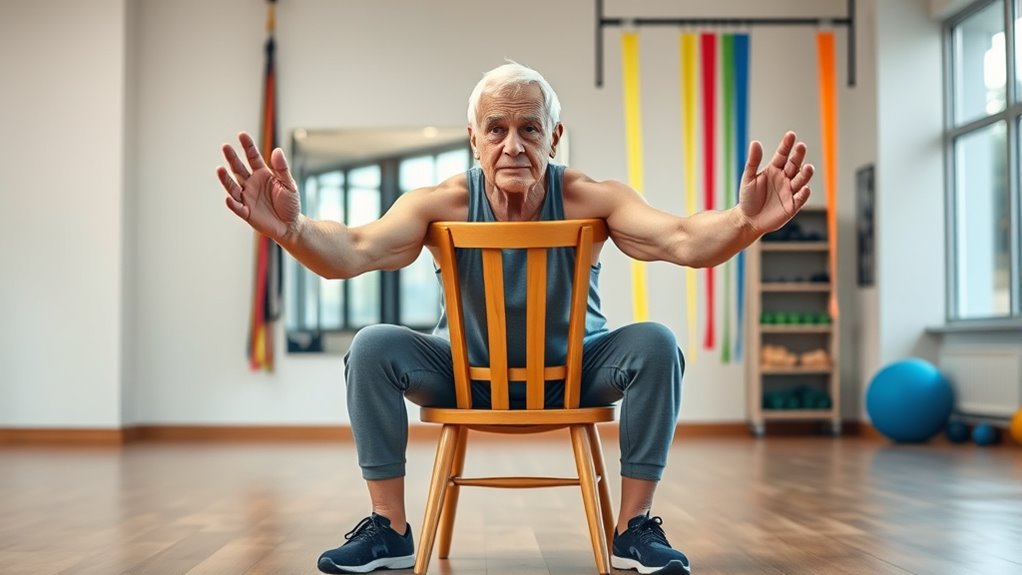
When doing chair squats, make sure your chair is positioned securely and at the right height to support your movement. Focus on maintaining proper squat form, like keeping your back straight and knees aligned with your toes. Always prioritize safety by moving slowly and stopping if you feel any pain or discomfort. Incorporating aquatic exercises can also be beneficial for low-impact strength training. Additionally, understanding trust issues can help build confidence in your progress and ensure safety during your routines. Developing proper technique is essential for preventing injuries and maximizing benefits. Recognizing the importance of consistent practice can further improve your strength over time. Remember that fatherhood teaches us resilience and patience, qualities that are valuable when establishing new exercise habits.
Proper Chair Positioning
To perform chair squats safely and effectively, proper positioning yourself correctly in the chair is vital. Start by selecting a chair with an appropriate chair height—your feet should be flat on the ground, with knees bent at about 90 degrees. Adjust the chair if necessary to guarantee your thighs are parallel to the floor. Position yourself so that your hips are close to the front edge of the seat, providing stability. Use the armrest placement to support yourself if needed, but avoid relying on it to push yourself up. Keep your back straight and core engaged throughout. Make sure your weight is evenly distributed on both feet. Proper positioning helps prevent falls and ensures you target the right muscles during your squat. Additionally, paying attention to body alignment can further improve safety and effectiveness during the exercise.
Correct Squat Technique
Maintaining proper squat technique guarantees you get the most benefit while staying safe. Start by sitting back into your chair, ensuring your knees stay aligned with your toes. Avoid letting your knees go past your toes, as this can strain your joints. Keep your chest up and shoulders relaxed. When squatting, aim for a comfortable squat depth—not too deep—so you don’t lose control or strain your knees. Engage your core to maintain balance and stability. Push through your heels to rise back up, keeping your knees aligned and your movements controlled. Focus on smooth, deliberate motions to prevent injury and maximize muscle engagement. Proper technique makes chair squats effective for building lower body strength while protecting your joints. Incorporating safe exercise practices can further enhance your workout safety and effectiveness. Additionally, understanding resources and tools available for proper guidance can help you perform exercises correctly and avoid injury. Regularly consulting professional guidance can ensure you maintain correct form as you progress, and staying mindful of joint health can help prevent common issues associated with aging.
Safety Precautions
Safety precautions are essential to prevent injuries and guarantee you perform chair squats effectively. First, check with your healthcare provider about medication interactions that might cause dizziness or weakness during exercise. Second, always have a sturdy chair nearby to support your balance and prevent falls. Third, plan emergency contact procedures—keep a phone close and inform someone of your workout routine in case you need help. Make sure to warm up properly and listen to your body, stopping if you experience pain or discomfort. Avoid pushing through fatigue, and consider modifying movements if needed. These precautions help you exercise safely, reduce risks, and build strength confidently. Additionally, understanding your environment and ensuring proper air quality can prevent breathing issues during physical activity. Maintaining a safe exercise space and good ventilation can further enhance your safety. Being aware of angel numbers and their messages can also provide encouragement and guidance during your fitness journey. It is also beneficial to be aware of dreaming patterns, as they can reflect your emotional and physical well-being, helping you stay balanced. Paying attention to hydration levels is crucial, as dehydration can increase the risk of dizziness and fatigue. Prioritizing safety ensures your fitness journey remains effective and injury-free.
Seated Bicep Curls Using Light Weights

When doing seated bicep curls, focus on maintaining proper form to prevent injury and maximize benefits. Choose light weights that allow you to perform the exercise smoothly without straining. Pay attention to your technique and adjust the weights as needed to stay comfortable and safe. Incorporating proper technique can enhance effectiveness and reduce the risk of strain.
Proper Form and Technique
To perform seated bicep curls with light weights correctly, focus on maintaining proper form throughout the exercise. Proper alignment is key: sit upright with shoulders relaxed, elbows close to your sides, and wrists straight. Keep your movements controlled, avoiding swinging or using momentum. Remember to breathe steadily—inhale as you lower the weights, exhale as you lift. This helps engage your muscles effectively and keeps you centered. To picture the movement:
- Sit tall with feet flat on the floor, shoulders back.
- Keep elbows tucked in as you curl the weights toward your shoulders.
- Lower weights slowly, maintaining control and proper alignment.
Choosing the Right Weights
Choosing the right weights is essential to guarantee your seated bicep curls are both effective and safe. Start with light weights that allow you to complete your repetitions with proper form. As you build strength, gradually increase the weight to incorporate progressive overload, which promotes muscle growth without risking injury. When selecting equipment, consider comfortable grips and manageable sizes to prevent strain on your joints. Avoid weights that are too heavy, as they can compromise your technique and cause injury. Focus on controlled movements and full range of motion. Remember, the goal is consistent progress, not lifting the heaviest weight possible. Proper tire pressure and equipment selection can also help prevent injury and improve workout safety. Additionally, understanding training principles like proper form and gradual progression can maximize results and reduce the risk of overuse injuries. By choosing appropriate weights and gradually increasing them, you’ll enhance your strength safely and effectively. Maintaining proper technique and listening to your body are crucial for long-term success and injury prevention. Incorporating cost management strategies can help you stay within your fitness budget while maintaining effective equipment choices.
Standing Leg Raises to Improve Balance
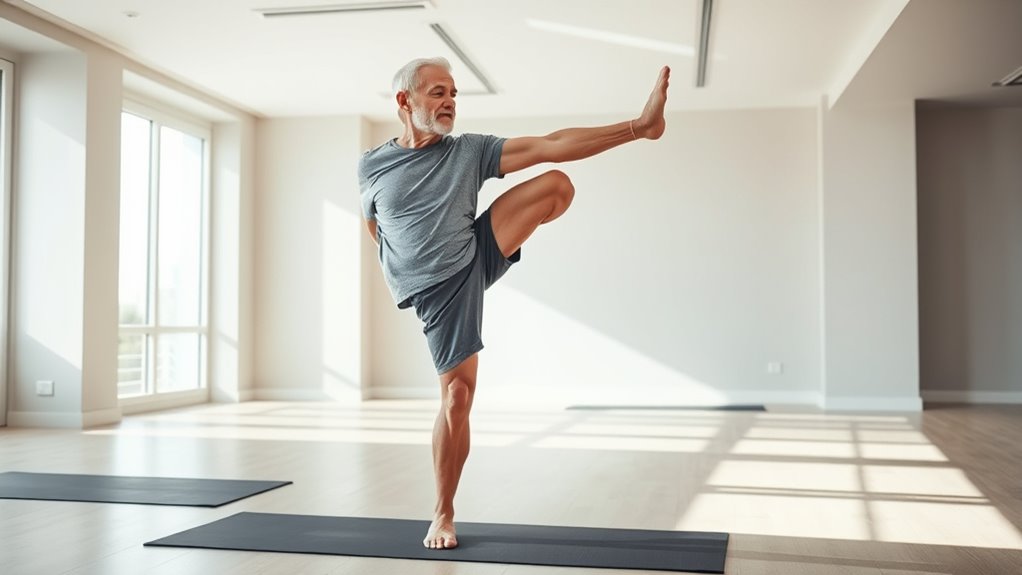
Standing leg raises are an effective exercise for elderly adults aiming to enhance balance and stability. This move targets your hip flexibility and ankle mobility, both vital for maintaining steady movements. To perform:
Standing leg raises boost balance and mobility by strengthening hips and ankles.
- Stand behind a chair, holding onto the back for support. Keep your core engaged.
- Lift one leg straight out to the side, keeping your hips level and ankle stable.
- Lower slowly and repeat with the other leg.
- Incorporating multiplayer options can motivate you to stay consistent with your exercises.
- Using headphones during your workout can help you listen to motivating music or guided instructions, making the exercise more enjoyable.
Focus on controlled movements to improve your balance. As you practice, you’ll notice better coordination and confidence in daily activities. This exercise strengthens the muscles around your hips and ankles, reducing fall risks and promoting overall mobility. Regularly doing standing leg raises can make a significant difference in your stability and independence.
Wall Push-Ups for Upper Body Power
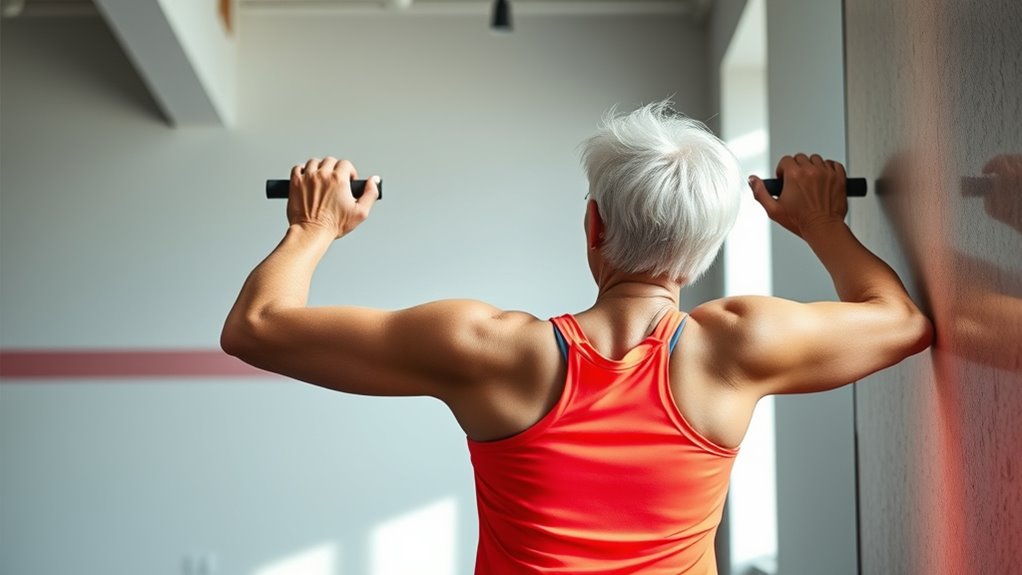
Wall push-ups are an excellent way for elderly adults to build upper body strength safely and effectively. This exercise helps with hand muscle strengthening and enhances overall arm and shoulder endurance. To perform, stand facing a wall, place your hands shoulder-width apart on the wall, and keep your body straight. Bend your elbows to bring your chest toward the wall, then push back to the starting position. Repeating this movement increases muscle strength without overexertion. Incorporating wall push-ups into your routine can also serve as a mild cardiovascular endurance exercise, boosting blood flow and stamina. They are easy to modify for beginners and can be done anywhere, making them a convenient addition to your strength training regimen. Regular practice helps improve upper body power and confidence in daily activities. Proper technique ensures safety and effectiveness during exercise.
Balance and Stability Exercises to Prevent Falls
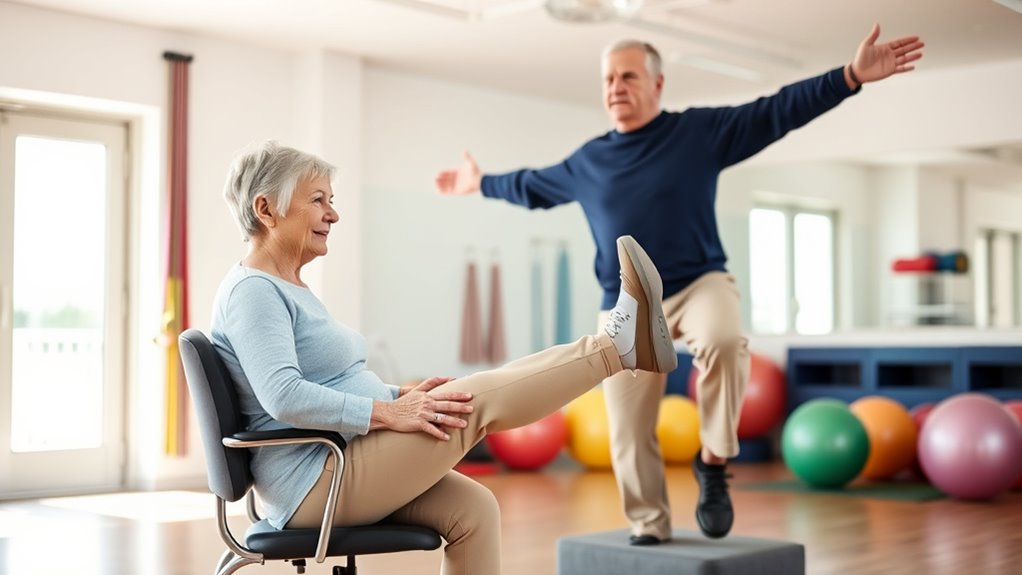
Maintaining good balance and stability is essential for preventing falls and ensuring safety as you age. Incorporate exercises that boost ankle flexibility and wrist strength, which are key to staying steady. To improve your balance, try standing on one foot, gradually increasing your time. Focus on keeping your ankles flexible to support quick adjustments. Incorporate gentle wrist circles to enhance wrist strength, aiding in stability during movement. Here are three exercises to get started:
- Heel-to-Toe Walk: Walk in a straight line, placing one foot directly in front of the other.
- Single-Leg Stands: Stand on one foot for 10-15 seconds, then switch.
- Wrist Rolls: Rotate your wrists clockwise and counterclockwise for improved wrist strength.
Frequently Asked Questions
How Often Should Elderly Adults Perform Strength Training Exercises Weekly?
You should aim for an exercise frequency of at least two to three times a week to see benefits without overdoing it. Keep your ideal workout duration around 20 to 30 minutes per session, allowing enough time for effective strength training while avoiding fatigue. Consistency is key, so stick to this routine, and you’ll improve your muscle strength and overall health gradually and safely.
Are There Any Safety Precautions for Seniors With Arthritis?
Imagine your joints as delicate bridges that need careful care. For seniors with arthritis, safety is key. Always prioritize joint protection by avoiding high-impact moves, and listen to your body’s signals. Consult your doctor about medication considerations before starting exercises. Incorporate gentle, controlled movements to reduce strain and prevent injury. With mindful adjustments, you can strengthen muscles safely while preserving joint health and enjoying improved mobility.
Can Seniors With Osteoporosis Do These Exercises Safely?
You can do these exercises safely if you have osteoporosis by following osteoporosis precautions and making exercise modifications. Focus on low-impact movements, avoid high-impact activities, and start slowly. Use proper form, listen to your body, and stop if you experience pain. Consulting your healthcare provider guarantees your workout plan is tailored to your needs, helping you strengthen bones while minimizing the risk of fractures.
How Can I Modify Exercises for Limited Mobility?
Imagine gently steering your exercises to better fit your needs. You can achieve this by using adaptive modifications and assistive devices, making movements easier and safer. Focus on gentle stretches, seated exercises, or light resistance bands. These adaptations help you stay active without strain. Always listen to your body, and consult a professional to tailor a routine that respects your mobility level. This way, you stay strong and confident.
What Signs Indicate Overexertion or Injury During Workouts?
During your workout, watch for signs of overexertion or injury, like muscle fatigue that feels unusually intense or persists longer than expected. Joint pain that worsens during or after exercise is a red flag. If you notice dizziness, shortness of breath, or sharp pain, stop immediately. These signals indicate you should rest and consult a healthcare professional to prevent further injury and guarantee safe, effective movement.
Conclusion
By incorporating these strength training exercises into your routine, you can boost your independence and confidence. Did you know that adults over 65 who stay active reduce their fall risk by up to 40%? Staying consistent not only improves your strength but also enhances your overall quality of life. So, take small steps today—your future self will thank you for it. Keep moving, stay strong, and enjoy your active years ahead!
